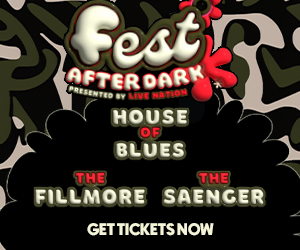Girl Talk’s new Feed the Animals is a sampling freak-out with over 300 credited samples, almost none of which are obscure. Girl Talk – Gregg Gillis – performs Friday night at the House of Blues, and his work recalls the excitement of the Beastie Boys’ Paul’s Boutique and De La Soul’s 3 Feet High and Rising as the breadth and creativity of the samples and their use was thrilling, independent of anything Mike D or Pas was saying. Gillis is too young to have heard those the first time around, and Public Enemy’s a more accurate reference. Here are highlights from a recent conversation with Gillis:
On the legality of that many uncleared (and unclearable) samples:
Fair use states that you can sample pre-existing works without asking for permission if the new work falls under certain criteria. It looks at the nature of your work. Is your work transformative, is it negatively affecting the sales of the source material, is it defacing the artist in any way, things like that. At the end of the day, I take a look at the new thing and decide if it ‘s transformative, if I made new music from old music, examining it on that level.
Some things are slightly, barely altered, and they stand by themselves for a moment, so I take a look at that, but for me, the whole point of this is the work at large, and track separation is an afterthought. Examining any second or minute of the album misses the point that this is one whole piece of music made from all these samples.
On Creativity:
All music, art, poetry, [and] creativity is based on previous ideas, and directly sampling those ideas is something in music that’s relatively new. In visual arts, it dates back a little more. It’s easy for people to think of a visual collage as a new piece of work, but people hang on to the idea of playing instruments as being original, even if they’re based on previous ideas.
On Pop Music:
I love “Nothing Compares 2 U”. I think it’s a great song. I love every song I sample. I am highly entertained by getting my hands dirty with standards and pop–pitch it up, manipulate it, put a beat underneath it, do what you want with it. That’s one of the main reasons I got involved with this. When I started, I was actively involved with more experimental music, doing very avant-garde stuff, but I was very interested in the juxtaposition of noise and pop.
On cratedigging for samples (and not doing that):
A lot of people who pioneered this like DJ Shadow have that world covered. In ways, it’s a bigger challenge to take a familiar song and make something new out of it. Whenever you take a song no one’s heard before and put a beat to it, of course it’s going to sound original. “Okay, how do I reinvent ‘Since You’ve Been Gone’?”
When I was growing up getting into hip-hop and rap music, you hear a sample manipulated and they’re playing with this nostalgic connection you have to that music. That’s at the heart of what I want to do–you recognize all these things, now I’m jumbling all these emotions and memories and playing with your history with pop music.




